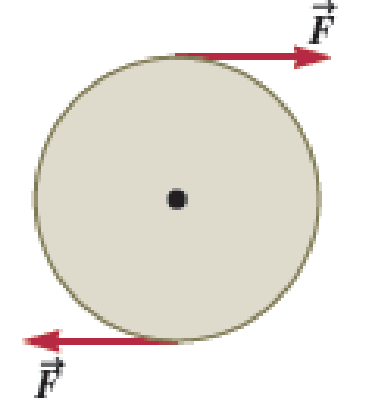
Concept explainers
A uniform disk of mass m = 10.0 kg and radius r = 34.0 cm mounted on a frictionless axle through its center, and initially at rest, is acted upon by two tangential forces of equal magnitude F, acting on opposite sides of its rim until a point on the rim experiences a centripetal acceleration of 4.00 m/s2 (Fig. P13.73). a. What is the

FIGURE P13.73
(a)
Angular momentum of the disk.
Answer to Problem 73PQ
Angular momentum of the disk is
Explanation of Solution
The disk in the question rotates about an axis passing through the center of the disk. Also the axis is perpendicular to the surface of the disk.
Write the equation to find the moment of inertia of the disk about an axis passing through its center.
Here,
Write the equation to find the centripetal acceleration felt by the disk.
Here,
Write the equation to find the linear speed.
Here,
Substitute equation (III) in (II).
Rewrite equation (IV) to get
Write the equation to find the angular momentum of the disk.
Here,
Substitute (V) to (VI) to get
Conclusion:
Substitute
Substitute
Therefore, angular momentum of the disk is
(b)
The time duration for which the force have to be applied so that the disk achieves the centripetal acceleration.
Answer to Problem 73PQ
The forces have to act for a time duration of
Explanation of Solution
Torque is the rate of change of angular momentum.
Write the equation to find the torque acting on the disk.
Here,
Rewrite equation (VIII) to get
Write the equation to find
Here,
Substitute above equation in (IX).
Change in angular momentum is the difference between the final angular momentum and initial angular momentum of the disk.
Rewrite equation (IX).
Here,
Conclusion:
The disk was initially at rest. Therefore
Substitute
Therefore, the forces have to act for a time duration of
Want to see more full solutions like this?
Chapter 13 Solutions
EBK PHYSICS FOR SCIENTISTS AND ENGINEER
- Solve and answer the question correctly please. Thank you!!arrow_forwardr 2. Measuring Length mm 1 cm 2 3 INCH 1 16THS 5 6 7 8 9 10 11 FAIRGATE COLD SPRING, NEW YORK 2 3 12 1. Using the metric (top) scale only, what units are being used for the long lines with the numbers? Hint: Remember that 2.54 cm = 1 in. 2. What are the units of the small lines? 3. How many decimal places should be recorded using this tool? 4. What is the length of the red line? Note: Make sure to use the correct units and decimal places. 5. Now observe your ruler. What metric units are used on your ruler? 6. How many decimal places should you record when using your ruler? 7. Measure a box, book, coin and can and fill out the data table below. Make sure to use units and the correct number of decimal places for your ruler. Table 1: Measuring Length Data Table Object Length of the box Length Local PR Distribution Only $99/Release. Get Started On Our Website Now! V 2 217arrow_forwardPROBLEM 3 Cables A and B are Supporting a 185-lb wooden crate. What is the magnitude of the tension force in each cable? A 20° 35° 185 lbsarrow_forward
- No chatgpt plsarrow_forwardhelp me with the experimental set up for the excel i did. the grapharrow_forwardWhich of the following best describes how to calculate the average acceleration of any object? Average acceleration is always halfway between the initial acceleration of an object and its final acceleration. Average acceleration is always equal to the change in velocity of an object divided by the time interval. Average acceleration is always equal to the displacement of an object divided by the time interval. Average acceleration is always equal to the change in speed of an object divided by the time interval.arrow_forward
 Physics for Scientists and Engineers: Foundations...PhysicsISBN:9781133939146Author:Katz, Debora M.Publisher:Cengage Learning
Physics for Scientists and Engineers: Foundations...PhysicsISBN:9781133939146Author:Katz, Debora M.Publisher:Cengage Learning College PhysicsPhysicsISBN:9781305952300Author:Raymond A. Serway, Chris VuillePublisher:Cengage Learning
College PhysicsPhysicsISBN:9781305952300Author:Raymond A. Serway, Chris VuillePublisher:Cengage Learning Principles of Physics: A Calculus-Based TextPhysicsISBN:9781133104261Author:Raymond A. Serway, John W. JewettPublisher:Cengage Learning
Principles of Physics: A Calculus-Based TextPhysicsISBN:9781133104261Author:Raymond A. Serway, John W. JewettPublisher:Cengage Learning Physics for Scientists and Engineers with Modern ...PhysicsISBN:9781337553292Author:Raymond A. Serway, John W. JewettPublisher:Cengage Learning
Physics for Scientists and Engineers with Modern ...PhysicsISBN:9781337553292Author:Raymond A. Serway, John W. JewettPublisher:Cengage Learning College PhysicsPhysicsISBN:9781285737027Author:Raymond A. Serway, Chris VuillePublisher:Cengage Learning
College PhysicsPhysicsISBN:9781285737027Author:Raymond A. Serway, Chris VuillePublisher:Cengage Learning Glencoe Physics: Principles and Problems, Student...PhysicsISBN:9780078807213Author:Paul W. ZitzewitzPublisher:Glencoe/McGraw-Hill
Glencoe Physics: Principles and Problems, Student...PhysicsISBN:9780078807213Author:Paul W. ZitzewitzPublisher:Glencoe/McGraw-Hill





